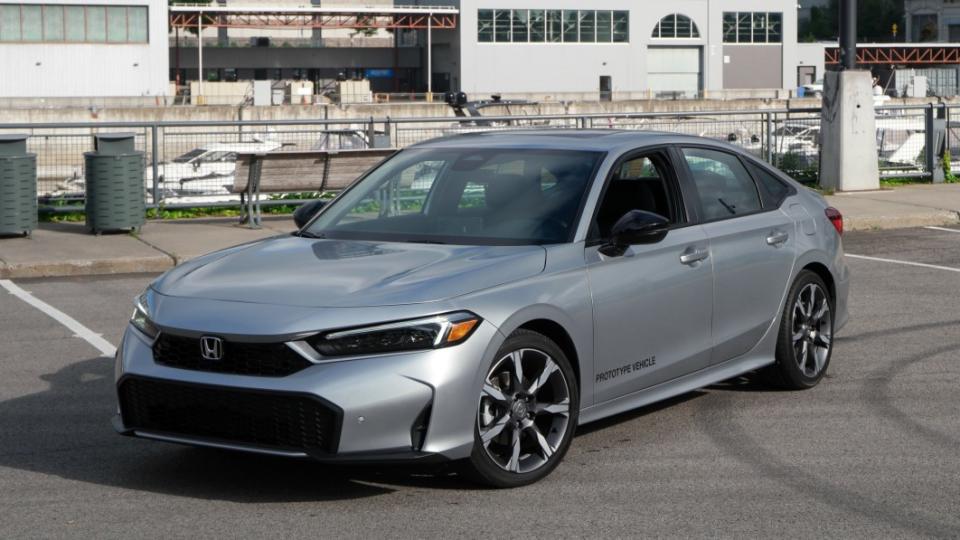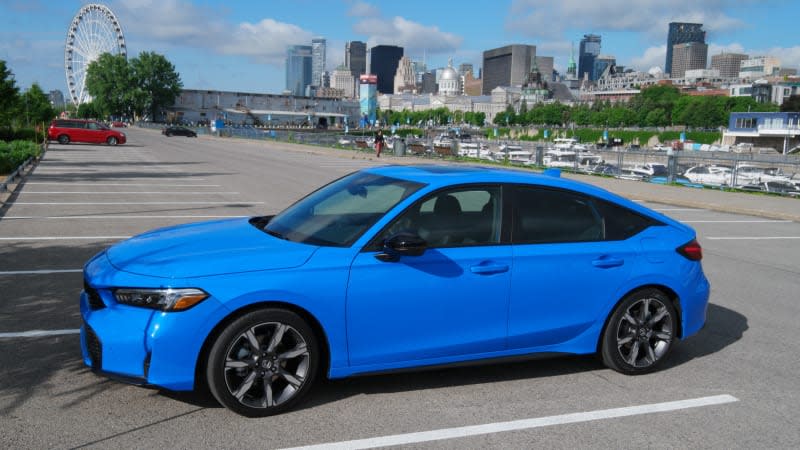2025 Honda Civic Hybrid First Drive Review: Leader of the pack

The Honda Civic may be one of the most ubiquitous cars on roadways across the United States. Seeing them so often could lull one into thinking of the compact car as little more than an appliance, an object to get from one point to another with as little fuss as possible. But that’s simply not the case with the Civic. It has consistently been one of the best cars for sale in America — a good reason why it’s proven so popular for so long — and the refreshed 2025 Honda Civic, particularly in the hybrid form we tested, may be the best all-around version yet.
The 2025 Civic’s single largest change for its mid-cycle freshening is the addition of a 2.0-liter four-cylinder hybrid powertrain with 200 horsepower that shares a lot with the hybrid available in the Honda Accord and CR-V. It also takes the place of the outgoing 180-hp, 1.5-liter turbocharged option. We loved the little turbo engine and will miss its hot-hatch-lite performance (not to mention the manual transmission that is also a goner), but we also think most drivers will be better served by the 200-horsepower hybrid replacement. It’s torquey, with a stout 232 pound-feet from 0 through 2,000 rpm spurred on by the electric motor and gearless eCVT transmission, but it doesn’t feel like it wants to live solely at low-rpm speeds when the driver calls up a heavy application of throttle.
Honda engineers tell us that the gasoline-fueled Atkinson-cycle engine doesn’t often put power directly to the wheels – it utilizes a high-speed lockup clutch at highway speeds for direct drive – but thanks to programming trickery, gearing and electricity from twin electric motors, it all just works in a shockingly seamless manner. We tested the hybrid in Econ(omy), Normal and Sport modes and found each of them well tuned for their respective purposes.
The default Normal mode is what we’d expect the majority of drivers to use, and it’s perfectly appropriate with linear throttle response and solid steering feel. Sport ramps up the throttle response and reduces steering assist (it also engages “Active Sound Control” for some additional auditory flair in the cabin and changes the digital gauges to a sportier look), and while the curviest roads we were able to drive during our two-hour stint behind the wheel in Montreal just prior to the Canadian Grand Prix were highway on- and off-ramps, it felt well-sorted for the task. Surprisingly, even Econ felt fine, eking out a bit more efficiency with smoothed-out throttle response and reduced use of the car’s air conditioning. The top-spec Sport Touring Hybrid gains an additional (new-for-2025) Individual mode that the driver can tailor to their liking.
The Civic Hybrid’s solid performance does not come at the cost of efficiency. It is expected to return 50 miles per gallon in the city, 47 on the highway and 49 combined. The Toyota Corolla Hybrid, which is the most logical competitor, gets 53/46/50 in LE trim or 50/43/47 in its sportier SE flavor. The Honda certainly feels much sportier from behind the wheel than the Toyota, earning it the nod as the driver’s choice between the two.
There are four levels of regenerative braking, switchable by using paddles to the left and right of the steering wheel. The default position — call it level 1, if you will — is basically none, while 2, 3 and 4 ramp up the regen in successive steps. Even at the most aggressive level, though, the 2025 Civic Hybrid doesn’t brake as hard as a fully electric car’s one-pedal driving mode, and it does not bring the car to a full stop.
All Civics get retuned springs and dampers and more rigid front upper suspension mounts, front subframe mount and rear lower suspension mounts. Hybrid models also benefit from a center of gravity that’s 10 millimeters lower than non-hybrids along with unique spring and damper tuning. The tires are said to have 19% less rolling resistance, but at the fairly sedate speeds we were forced to drive in traffic, we did not notice any reduction in grip.

 Yahoo Autos
Yahoo Autos 
